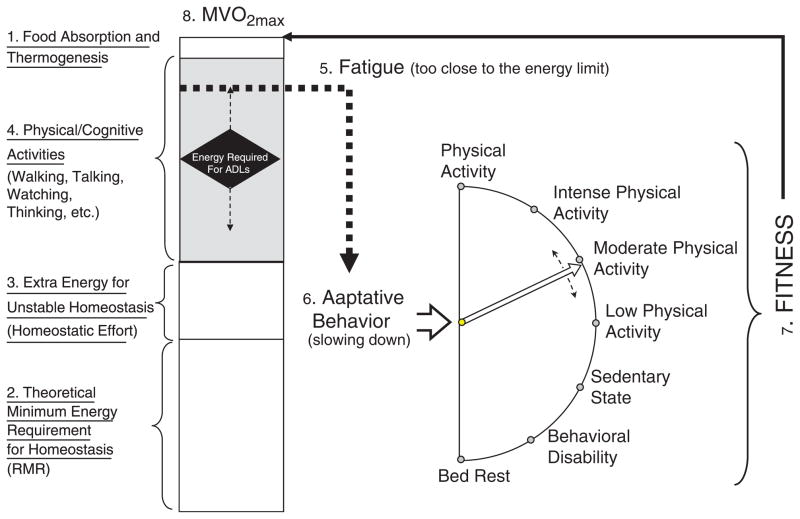Figure 1.
Hypothesized mechanisms for physical fatigue. The box in the left of the figure represents the total amount of energy potentially used by an individual within 24 hours. The size of the box is a measure of fitness and is estimated according to maximum oxygen uptake (MVO2) during a maximal treadmill test. Total energy can be partitioned into portions that serve different purposes. At the top1 is the small amount of energy necessary to process food during digestion and to avoid excessive fluctuation in body temperature. At the bottom2 is the theoretical minimum energy requirement for homeostasis at rest or resting metabolic rate (RMR). The RMR represents 40% to 65% of the total energy used daily and tends to be lower in women, in individuals with less lean body mass, and in older persons. In the presence of pathology and physiological dysregulation, an extra portion of energy is required to maintain homeostatic equilibrium, homeostatic effort,3 or extra energy for unstable homeostasis. The remainder in the middle of the box shaded in gray is the energy used daily for physical and cognitive activities.4 In young and healthy individuals, there is abundant energy left to perform activities of daily living and much more for other activities. In older individuals, because of the reduction in fitness (the whole box is smaller), the extra energy necessary for homeostasis, and the reduction in biomechanical efficiency, additional energy is required to perform the same task, as indicated by the position of the diamond in the middle box. Thus, in some older individuals, performance of basic daily activities may require near maximum energy available. This condition is perceived by the brain as an “alarm” (energy is becoming scarce) and generates “fatigue.”5 The adaptive behavior6 to fatigue is a reduction of physical activity (an attempt to slow down the body and spare energy), which in turn leads to a reduction in fitness,7 further reducing the total energy available and then generating more-severe fatigue, in a vicious cycle. Major challenges to the operationalization of this model are the development of noninvasive methods for measuring MVO2 in 24 hours and the additional portion of energy required to balance homeostatic dysregulation.

